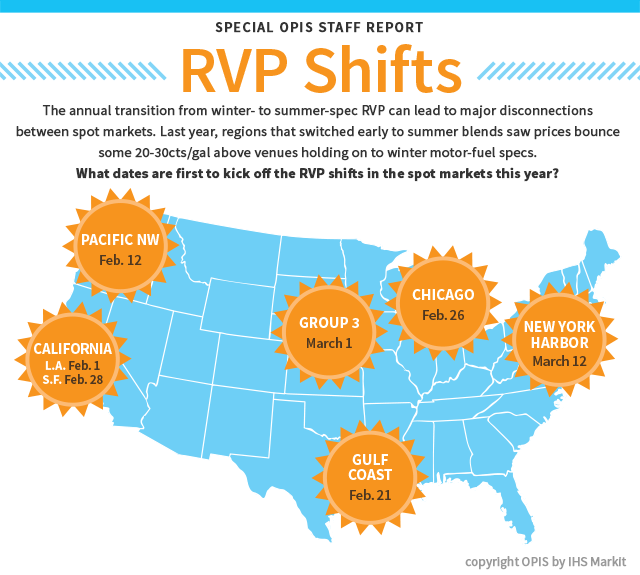Summer Gasoline Prices Potentially Bullish
It may be the middle of the winter season, but some U.S. gasoline traders are already looking ahead to summer. And they say summer gasoline prices may be on a track to higher ground, based on fundamental evidence and pricing structure compared to years past.
Let’s take a second to clarify what gasoline traders mean by summer. They really push the season. Summer gasoline months – displaying peak demand and the most active trading of the year – cover a span of six months from April to September.
- This is also called the low-RVP season. Want to see when that starts in the spot market, plus a very cool infogaphic? Jump to the bottom of this blog.
An early look at the peak gasoline market of summer 2018 reveals a potentially bullish market scenario, with strong demand, low inventory and a steep price backwardation.
What is Backwardation?
Traders like to look at what prices are like now compared to points in the future – otherwise known as a forward curve. When prices are stronger in the near-term and cheaper later on, that’s called “backwardation.” It’s a typically bullish market condition, as there’s really no incentive in that scenario to store product to sell in the future. So, the supply condition can quickly become hand-to-mouth.
In a recent futures market snapshot, the NYMEX April-September RBOB price spread was at a backwardation of about 9cts/gal. That may not seem like a lot, but it’s a big increase compared with a year ago, when the intermonth spread was relatively flat. That’s raised trader awareness that this summer might feature stronger gasoline prices once the season rolls around and backwardation “catches up with the market.”
Backwardation doesn’t just happen in a vacuum. The current backwardated curve is supported by the perception of relatively tight inventory in PADD1 (the Northeast United States) compared with a year ago.
Gasoline stocks for PADD1 for the week ended Jan. 26 were pegged at 63.317 million bbl, compared with 73.54 million bbl a year ago and 67.701 million bbl two years ago, according to the Energy Information Administration.
A falloff in imports is partially to blame. Gasoline imports into the U.S. averaged at 436,000 b/d for the rolling four-week period ended Jan. 26, compared with 588,000 b/d during the corresponding period in 2017.
Meanwhile, pipeline deliveries from the U.S. Gulf Coast have been negative, partly due to high refinery utilization in the Northeast (95% of capacity for the week ended Jan. 26, as a recent example).
Line space value for gasoline delivery on Colonial Pipeline’s Line 1 from the Gulf Coast to the Mid-Atlantic was valued at a discount at around flat to minus 100 points. A negative line space value typically reflects a closed arbitrage window for the south-to-north deliveries. It also means a shipper would pay someone else to ship products.
Prices in the spot market support this bullish scenario. Need a refresher on spot markets? Click here.
The low gasoline inventory was recently reflected in a slight prompt cash price premium to the NYMEX futures market for New York Harbor spot RBOB at 25pts/gal. Again, that may not seem like a whopping premium. But compare it to same-time last year, when that same market sported a hefty prompt cash discount of about 6.5cts/gal.
- Tip: Spot market moves tip you off to what is going to likely happen at the wholesale rack. See how you can keep track.
The fears of a summer spike is pushing some gasoline traders to start storing high-octane gasoline components – as alkylate, reformates and possibly aromatics – to potentially get ahead of a summer shortfall during the winter demand lull.
For the components market, traders are hoping to ride the trend of a near-term contango.
What is Contango?
It’s the opposite of backwardation. A contango market features prices that are cheaper in the near-term and stronger later on. Unlike backwardation, it encourages storing product for sale in the future. So, it’s bearish in the long view.
The NYMEX March-April RBOB spread was at a contango of 17.63cts/gal in a recent snapshot. That’s offering enough financial incentives for some gasoline blenders and players to store components.
But some sources note it can be difficult to source alkylate in the middle of winter. Also, alkylate prices have been relatively strong, along with the value for octane in gasoline, due to high demand for cheap naphtha to make winter gasoline. So, this is not an easy strategy.
Apart from the winter and summer price indicators pointing the way to bolder summer prices, U.S. gasoline demand fundamentals are also looking strong. The U.S. is expected to see robust gasoline demand, mainly supported by brisk export sales to Mexico and South America.
However, it is still winter. The gasoline market dynamics may change quickly over the next few months, as the market is expected to build stocks for the peak demand in summer. You can bet this will keep markets fluctuating once RVP season starts.
What does the RVP (Reid Vapor Pressure) Season Shift Mean for Fuel Markets?
RVP, or Reid Vapor Pressure, measures gasoline pressure and is mandated to specific levels by state and local governments as an ozone control mechanism. It’s higher in the winter and drops lower as the market gets closer to summer.
It’s also a time that sees spot gasoline trend naturally higher. It’s good to keep some dates in mind as spot RVP levels can creep up on you and then impact prices at the rack.
The graphic below gives you some approximate dates for 2018’s spot moves.

- GULF COAST: Colonial Pipeline will allow 11.5-lb. RVP CBOB, Premium CBOB, unleaded gasoline, and premium gasoline starting on Feb. 21 with the start of Cycle 21 as prompt-timing. The 11.5-lb. RVP RBOB and RBOB premium will be allowed starting Feb. 27 with the beginning of Cycle 13. Summer-grade 9.0-lb. RVP premium CBOB and premium unleaded will appear starting March 8, at the start of Cycle 15. VOC-controlled RBOB and RBOB premium will appear in prompt-timing starting March 8 with the beginning of Cycle 15. The 9.0-lb. RVP CBOB and unleaded gasoline will appear starting March 13 with the start of Cycle 16.
- NEW YORK: Shipments of gasoline via barge or Buckeye and Laurel pipelines will see an RVP shift from 15.0 lb. to 13.5 lb. on March 12. On April 9, New York gasoline RVP shifts from 13.5 lb. to summer-grade blends and OPIS will start tracking VOC-controlled RBOB and 9.0-lb. and 7.8-lb. CBOBS.
- CHICAGO: Chicago premium and regular unleaded gasoline will shift from a 15.0-lb. RVP to 13.5-lb. RVP on Feb. 26. On March 15 the region will transition to a 9.0-lb. RVP, where it will remain for the rest of the summer.
- GROUP 3: Group 3 “V-grade” sub-octane gasoline will transition from 13.5-lb. RVP to an 8.5-lb. RVP at origin on March 1. In May, the Group will switch over to 9.0-lb. RVP for the remainder of the summer. “A-grade” premium unleaded gasoline will shift to 8.5-lb. RVP from 10.0-lb. RVP on March 1.
- LOS ANGELES: On Feb. 1, prompt Los Angeles regular and premium CARBOB gasoline assessments have transitioned to February any timing with a 5.99-lb., summer-grade specification.
- SAN FRANCISCO: Around Feb. 28, during the second March shipping cycle of Kinder Morgan’s North Line, prompt San Francisco regular and premium CARBOB gasoline assessments will shift to a 5.99-lb., summer-grade specification.
- PACIFIC NORTHWEST: On Feb. 12, prompt Pacific Northwest regular and premium sub-octane gasoline assessments will transition to 13.5 lb. On March 12, prompt Pacific Northwest gasolines will shift to 9.0 lb. On April 30, prompt Pacific Northwest mogas markets will begin to reflect a 7.8-lb., summer-grade specification.
The best way to stay on top of any price change caused by a move in RVP is to sign up for the OPIS Spot Ticker, where our editors update spot gasoline deals and fresh price indications in real time.
